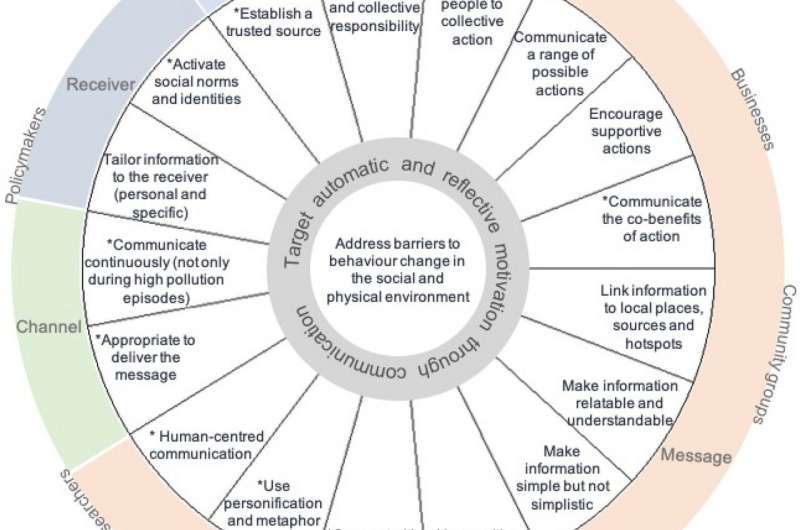Reducing air pollution: How can changing behaviors help?

Changing people's behaviors is key to improving urban air quality, but it should be done in a way that involves the community, say researchers.
Air pollution ranks fourth among major risk factors for global disease and mortality. In the UK, it contributes to between 28,000 and 36,000 deaths annually, with an estimated economic cost of more than £20 billion every year.
With the World Health Organisation this month releasing updated, stricter guidelines for air quality, the need to reduce air pollution has never been more urgent. While research and policy have focused on regulations and technological solutions to urban air pollution, some researchers have suggested that encouraging behavior change represents a win-win scenario that could reduce both overall concentrations of air pollution and the public's exposure.
Now, a team from Imperial and institutions in Japan have explored studies into behavior change related to air pollution, to discover the best methods and opportunities for new ways forward focused on community engagement. We spoke to lead researcher Dr. Audrey de Nazelle, from the Centre for Environmental Policy at Imperial, about their results, published in the journal Sustainability Science.
What kinds of behaviors to reduce air pollution and the public's exposure to it have been studied?
Governments can enact 'hard' policies to affect public behavior, such as driving and parking restrictions, low emission zones or tax increases on more polluting vehicles; or they can use 'soft' policies targeting behavior change, such as public communication, social marketing, or education campaigns.
"Soft' voluntary behavior changes fall into three main types: avoidance (e.g., reducing outdoor activity when levels are high to avoid exposure), contributing (e.g., reducing idling), and supporting (e.g., civil engagement through campaigning). Avoidance schemes, such as providing information and warnings on high air pollution levels, are the most used and studied, followed by contributing behaviors, particularly around reducing driving—although these have mixed results.
Supporting behaviors are least studied but show promising results, with the added benefit that supporting local and national policies may eventually lead to the removal of social and physical barriers that prevent wider behavioral changes. This could be, for example, by improving bike lanes or providing safe and well-lit routes for walking, and improving the affordability and timeliness of public transport.
How does the method of communication affect how likely people are to change their behavior?
Most studies we looked at had a 'top-down' approach: experts and authorities disseminating information to the public. However, a few studies also looked at more 'participatory' approaches that engage the public in the design or development of air pollution communication or to engage in ways that go beyond the provision of facts.
By engaging communities as a whole, such approaches may be more likely to eventually change norms and the broader cultural and policy context within which individual behaviors and social practices take place. Even the most 'perfectly' worded messages delivered at the right time will not change a person's behavior if they do not have the physical or social opportunity to engage.
This area requires further research, but there is promise in communications that seek to engage the public's emotions, tap into social identity, and connect people to collective action.
Tackling air pollution can have co-benefits, such as promoting health through active transport. Does promoting these benefits help people change their behavior?
It can do, if those co-benefits are something those people value. Different people will be driven by different considerations. While some may value the health benefits of switching some car use for walking or cycling, others may be more motivated by the reduction in carbon emissions from such a switch.
There may also be economic and convenience drivers. For example, during the current fuel shortages, more people may be tempted to switch to walking, cycling or public transport for things they used to drive to, like buying groceries. This could translate into long-term changes. However, it is an underexplored area.
How can communicators strike the right balance between encouraging individual actions whilst acknowledging that much of the changes must occur at local or national government level?
Some research has shown that overall, the public feels individual-level action on air pollution and the environment is futile and that responsibility for improving air pollution primarily lies at the local and national level. We therefore recommend in our paper that communication recognizes these expectations and frames action on air pollution as a collective responsibility by demonstrating collective action and leadership.
Connecting people in the pursuit of collective action can be a powerful source of change that is both individual but encourages system change. For example, while taking children to school on bicycles may feel too risky, joining a community group that lobbies for cycling infrastructure may be less daunting to some, and provides a route to removing barriers for those who may want to take up more cycling.
Much air pollution communication raises concerns without providing solutions, or suggests single solutions that one person may not be able to take, or feel will make a difference. Giving people a range of actions, such as writing to local MPs, engaging in discussion and actions with the local community and joining or contributing to pressure groups, increases self-efficacy, prevents disengagement, and may encourage behavior change.
More information: Rosie Riley et al, How do we effectively communicate air pollution to change public attitudes and behaviours? A review, Sustainability Science (2021). DOI: 10.1007/s11625-021-01038-2
Journal information: Sustainability Science
Provided by Imperial College London




















